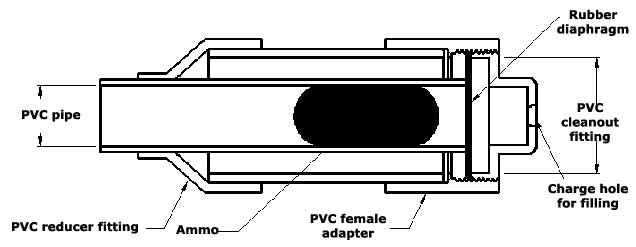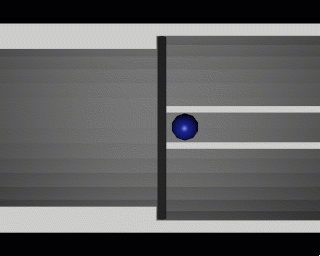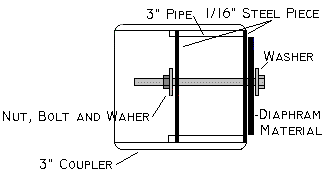
Air Cannon Basics "Build-it-Yourself"
WARNING: No Liability Is Assumed By The Developers Of This Website and All Literature Is Provided Second Hand, Use It At Your Own Risk!
What is a pneumatic launcher?
A pneumatic launcher or air cannon is basically a device that uses compressed air to launch something. They are a great experiment to demonstrate projectile motion. See physics behind projectile motion.
Many people launch potatoes or other veggies for fun however other practical uses for air launchers are used. Various research groups use air launchers to test aircraft windshield strength and durability by simulating bird impacts. Pneumatic launchers are also used for avalanche control, and have been used to simulate hurricane impacts by launching wood into houses to see how engineers can improve homes to withstand hurricanes and save lives.
How an air cannon launcher works
Basically there is a large tank pressurized with air. All this air is released suddenly and this energy is what propels the projectile. There are many different designs of pneumatic cannons. The air can be released by several different methods. A standard ball valve can be used, a solenoid activated valve, or more complex diaphragm and check valves.
Standard store bought valves can have there limitations due to low flow rates. Building your own oversized check valve can be more effective.
Below is an example of a air launcher that uses a flexible rubber diaphragm.

Air is filled into the cannon through the charging hole located on the cleanout cap. The diaphragm is somewhat flexible and it will bend it's outer edges forward from the pressure and allow the air to fill the outer chamber. At the same time this forward pressure is sealing off the end of the barrel preventing air from escaping up the barrel.
Pulling the blowgun out of the charging hole allows the air behind the diaphragm to escape. At this point all the pressure stored in the outer chamber bends the diaphragm in the opposite direction sealing off on the outer edge of the cleanout plug. The diaphragm continues to bend under the pressure and unseals the barrel end allowing the stored air to escape up the barrel behind the spud. The diaphragm allows a larger volume of air to enter the barrel.
 Below
are some animations and images that give a better illustration of how
this cannon works.
Below
are some animations and images that give a better illustration of how
this cannon works.
Click to get a bigger version.
|
|
Gun is loaded, with no pressure. |
|
|
The release valve is shut |
|
|
Pressure is pumped in. The two air chambers equalize, because the pressure leaks around the diaphragm. |
|
|
Pressure stays in. The barrel is a "low-pressure" zone, and sucks the diaphragm toward it. This keeps it sealed. |
|
|
Open the release valve, and the first chamber depressurizes. This sucks the diaphragm away from the barrel, so the air can escape, firing the bullet. |
|
|
Gun is empty and depressurized. |
 The
flexible diagram material can be replaced with a piston that actually
moves within the launcher.
The
flexible diagram material can be replaced with a piston that actually
moves within the launcher.
This moving piston creates a larger opening for the air to get from the air chamber to the barrel, thereby making the cannon more powerful.
A piston can actually move (not just flex) 2 inches or more.
When the air is charged in the cannon, the piston moves forward and seals against the barrel, much like the cannon above. When there is a sudden drop of pressure behind the piston, the piston is sucked back, letting the air enter the barrel.
Air Cannon Piston
 The
piston shown here is constructed out of a 3" coupler made to fit into
4" pipe.
The
piston shown here is constructed out of a 3" coupler made to fit into
4" pipe.
How a air cannon combustion launcher works:
A more commonly known launcher is the "hair spray" potato cannon. This launcher is basically various pieces of PVC, that are glued together to make something that looks like a cannon with 2 distinct parts. The first part is the barrel (which the ammo is shot out of), and the second part is the Combustion/Blast chamber (where the propellant is ignited).
Propellant (hair spray for example) is sprayed into the Combustion Chamber and the combustion chamber is sealed. The propellant is ignited and expands, forcing the projectile out of the barrel.
![]() Combustion
Combustion
How to use this type of cannon:
First get something to shoot; a potato, apple, etc... Then ram the projectile down the barrel with something such as a broom handle. Now unscrew the end cap, spray in some hair spray or other propellant and quickly put the end cap back on. You're ready!! Now all you have to do is set off the igniter and BOOM! Off it goes.
